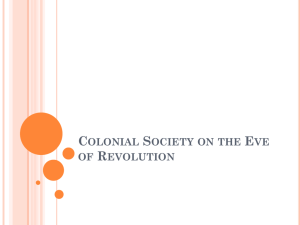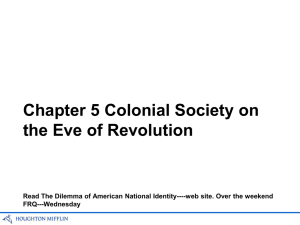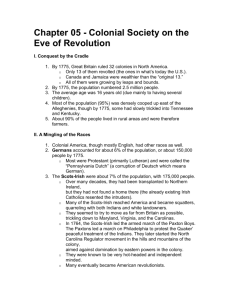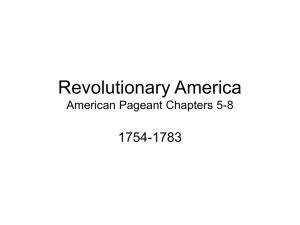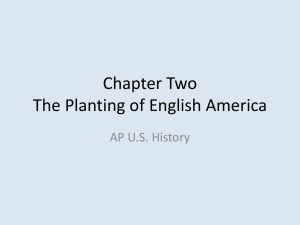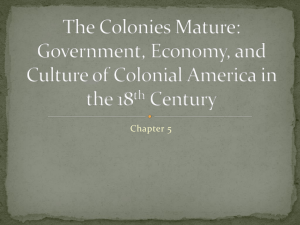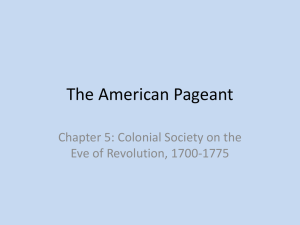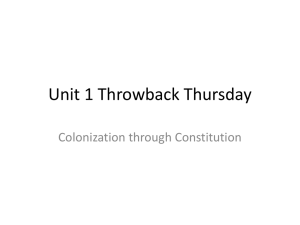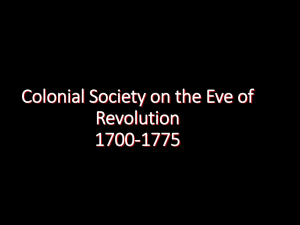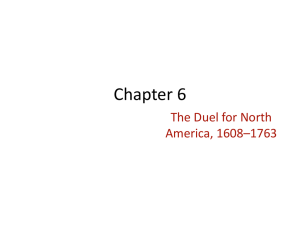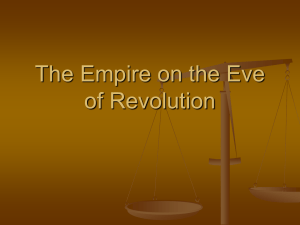Colonial Society on the Eve of Revolution
advertisement
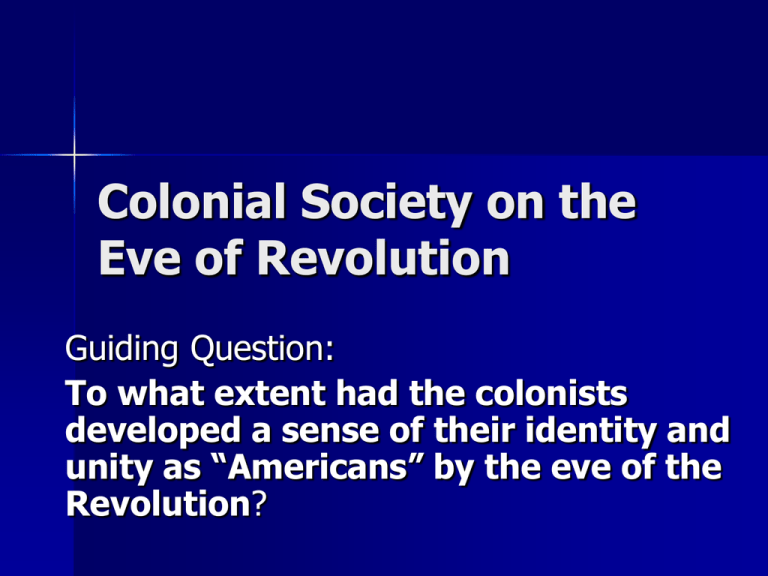
Colonial Society on the Eve of Revolution Guiding Question: To what extent had the colonists developed a sense of their identity and unity as “Americans” by the eve of the Revolution? Conquest By the Cradle Huge increase in population – 1700: 300,000 people in America; 20,000 blacks – 1775: 2.5 million people in US; 500,000 were black 400,000 were new immigrants; additional 400,000 were blacks slaves Rest was natural fertility of Americans colonists doubled their numbers every 25 years Conquest By the Cradle Political importance of increasing population – 1700: 20 English subjects for every American colonist – 1775: 3 English subjects for every American colonist Political power shifting to American colonies Mingling of the Races Germans – 1775 – 6% of the population (150,000) – Early 1700s – settled chiefly in Pennsylvania Known as Pennsylvania Dutch (“Deutsch” means German) Moved to backcountry and worked industriously – Primarily Lutheran – Not loyal to British crown – Clung to German heritage and language Mingling of the Races Scots-Irish – 1775: 7% of the population (175,000) – Scottish who had been exiled to Ireland before emigration to America – Early 1700s: settled chiefly in Pennsylvania as squatters, but also rural Maryland, Virginia, and Carolinas – Primarily Presbyterian – Quick to attack and retaliate against Indians – Had no loyalty to British government that had persecuted them in Europe Mingling of the Races Other ethnic groups – 1775: 5% of the population – French Huguenots (Protestants), Welsh, Dutch, Swedes, Jews, Irish, Swiss, Scots Highlanders – Generally little loyalty to British African slaves – 1775: 25% of the population – Heavily concentrated in South Mingling of the Races 13 colonies – Primarily Anglo-Saxon, but most ethnically diverse population in world at time South – Mixed black and white (with 90% of all slaves) North – Primarily Puritan and least ethnically diverse Middle colonies – Most ethnically diverse (especially Pennsylvania) The Structure of Colonial Society America in 1700s: land of equality and opportunity (for whites) compared to Europe – No titled nobility – No poor underclass – Most were small farmers – Skilled artisans and unskilled day laborers worked in cities The Structure of Colonial Society New England – descendents of original settlers faced more limited prospects – Supply of land dwindled (near coast and major cities and away from Indians); estates repeatedly subdivided – Younger sons and daughters forced to work as wage laborers or move west (beyond Alleghenies) for unclaimed land – Many landless poor looked to public charity for survival in major cities The Structure of Colonial Society South – rich planters held power and riches because of their disproportionate ownership of slaves – Wealth concentrated among largest slave owners – Slavery widened gap between planters and poor whites The Structure of Colonial Society Black slaves – No equality with whites – No hope of improving social status – Closest approximation to England’s oppressed lower classes – Real fear in South that they might rebel – Some in South (like South Carolina in 1760) tried to ban importation of more slaves Main Street Economics Agriculture – 90% of the people involved – Chesapeake Mainly tobacco Wheat also spread – Middle colonies Primarily grain (the “bread” colonies Fishing (including whaling) – – – – Principally in New England Cod exported to Europe Stimulated shipbuilding Served as training for future navy Main Street Economics Commerce (trade) – Especially in New England, New York, and Pennsylvania – Shipped food and forest products to Caribbean – Brought gold, wine, and oranges to Europe – Brought industrial goods from Europe to America Main Street Economics Triangular trade 1. Rum shipped from New England to Africa and traded in Africa for slaves 2. Slaves shipped to West Indies and traded for molasses 3. Molasses shipped to New England and distilled into rum Main Street Economics Manufacturing – Secondary because of ease of finding good land to farm and British trade restrictions Beaver hats Household manufacturing (spinning, weaving) Carpentry Lumbering was most important single manufacturing activity for shipbuilding (primarily in New England) Shipbuilding – Colonies had important (and relatively rare) materials such as tar, pitch, rosin, and turpentine Huge trees in colonies used for British ships Economic Problems Shortage of Currency – No Commonly accepted medium of exchange – No “Specie” (Gold or Silver Coin) – Experimented at different times with forms of paper currency Lack of Order in Trade – Merchants could not guarantee production – Distance made communication difficult Economic Problems Restrictions on Trade – British Navigation Acts resulted in Trade Imbalance American goods shipped to Europe had to pass through British ports where taxes were collected Americans had to buy British goods Britain became saturated with American products so did not buy nearly enough Americans became infamous for smuggling so as to avoid British taxes The Fight for the Soul Established churches – Congregational Massachusetts (including Maine), Connecticut, New Hampshire – Anglican Maryland, Virginia, North Carolina, South Carolina, Georgia, New York (only in NY City and 3 neighboring counties) – None Rhode Island, New Jersey, Delaware, Pennsylvania The Fight for the Soul Religious Toleration – People were generally free to worship as they pleased – Catholics were discriminated against but not the level of England 18th Century was less religiously fervent than 17th Century – Puritan Church had 2 problems Elaborate doctrines Compromises to liberalize membership requirements Great Awakening (1730s-1740s) Spiritual Revival that swept through the colonies -Particularly powerful with women and youngest sons who were less likely to inherit land -Led to large increases in church membership (particularly Presbyterian & Baptist churches) -Creation of new colleges (Princeton, Dartmouth, Brown, and Rutgers) -Encouraged missionary work among Indians and black slaves Great Awakening Jonathan Edwards – “Sinners in the Hands of an Angry God” Hellfire and Brimstone! – Fought idea that good works were enough to be saved – God’s grace was only way to get to heaven – Preaching style was learned and closely reasoned, but used brutal doctrines to catch people’s attention Great Awakening George Whitefield – Powerful preacher who used speaking skills to reach people – Went on “Evangelizing Tours” throughout the colonies and spoke to thousands of people in open-air revivals The Enlightenment Due to the intellectual and scientific achievements in Europe during the 17th Century, thinkers began to celebrate the power of human reason. Intellectuals argued that humans did not need to turn to God for guidance in making decisions. Thinkers like Ben Franklin, insisted through reason, men and women could move civilization to greater heights. Education in the Colonies Traditional English view of Education – Reserved for aristocratic few (white males with land and titles) – Commoners were generally left to their own accord to educate themselves and their children Colonists placed a high value on education – Dame schools, master craftsmen schooling, Quaker schools – By 1775, ½ of white men were literate – Harvard College established in 1636 outside Boston – “Liberal Arts” Education News in the New World Pamphlets, leaflets, journals – – – – Printed by hand-operated printing presses 1775- 40 colonial newspapers Weeklies consisting of 1 large sheet, folded in ½ Long, complex essays signed with Romansounding names “news” might lag weeks behind the event (especially overseas events) Newspapers were powerful way colonists could rally support around rebellion against British Law and Order Zenger case – – – – – John Peter Zenger, newspaper printer brought to court for criticizing a corrupt royal governor Charged with seditious libel (sedition means inciting to rebellion; libel means printing something that damages someone’s reputation) Law said that truth or falsity of what Zenger wrote did not matter Zenger’s lawyer (Alexander Hamilton) eloquently argued that “the very liberty of both exposing and opposing arbitrary power” was at stake Jury sided with Hamilton, returning verdict of not guilty; Made newspapers (eventually) free to publish responsible criticism of powerful officials
